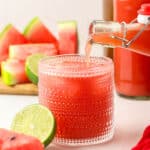
Watermelon Kombucha Second Ferment
Watermelon kombucha is the perfect flavor to second ferment for summer. With real fruit and probiotic goodness, it's lovely on a warm day!This recipe will make about four 16oz bottles.
Servings 8 servings
Calories 73kcal
Equipment
Ingredients
Watermelon Puree
- 7 cups watermelon cut into small cubes
- 2 limes juiced
- 2 teaspoons sugar optional
Watermelon Kombucha
- 4 cups fermented kombucha green tea kombucha works well
- 4 cups watermelon puree
Instructions
- Place watermelon cubes, lime juice, and sugar (if desired) into a blender. Blend on high until you have a nice, smooth watermelon mixture.
- Gently swirl the fermented kombucha (from the first fermentation process) before you pour it into the bottles to evenly distribute the yeast.
- Use a funnel to pour the fermented kombucha into swing-top bottles, or any bottle that has a tight-fitting lid, to halfway full (about 1 cup per bottle).
- Add the watermelon puree to each bottle, leaving about an inch of headspace at the top of the bottle
- Seal the bottles tightly and store them at room temperature out of direct sunlight.
- As the fermentation process occurs, you will notice little bubbles forming at the top and the yeasts will float. Check the bottles daily and “burp” them at least once daily to release pressure. If there is built up pressure and bubbles race to the top, then move the bottles to the refrigerator. The 2 fermentation process can take anywhere from 1-3 days depending on the ambient temperature (warmer temps will ferment faster).
- Chill the bottles in the refrigerator before serving.
Notes
- I blend the watermelon, seeds and all, because the seeds contain nutritional benefits such as added vitamins and minerals. Feel free to use a seedless watermelon, if you prefer.
- I use green tea kombucha for this recipe because the flavor is lighter and pairs really well with watermelon, but black tea kombucha can also be used.
- It is important to check this kombucha daily for carbonation. Watermelon kombucha has a tendency to complete the second fermentation process very quickly.
- Watermelon kombucha will naturally separate, but it will still get fizzy. To mix it back up, gently turn the bottle upside down or roll it on its side to mix it back up.
- The bottles can go right into the refrigerator for the second ferment if you prefer, but it will slow down fermentation.
- Be sure to mark the date that you bottled so that you can keep track of how long it’s been to help prevent any bottle explosions due to built up pressure.
Nutrition
Serving: 1cup | Calories: 73kcal